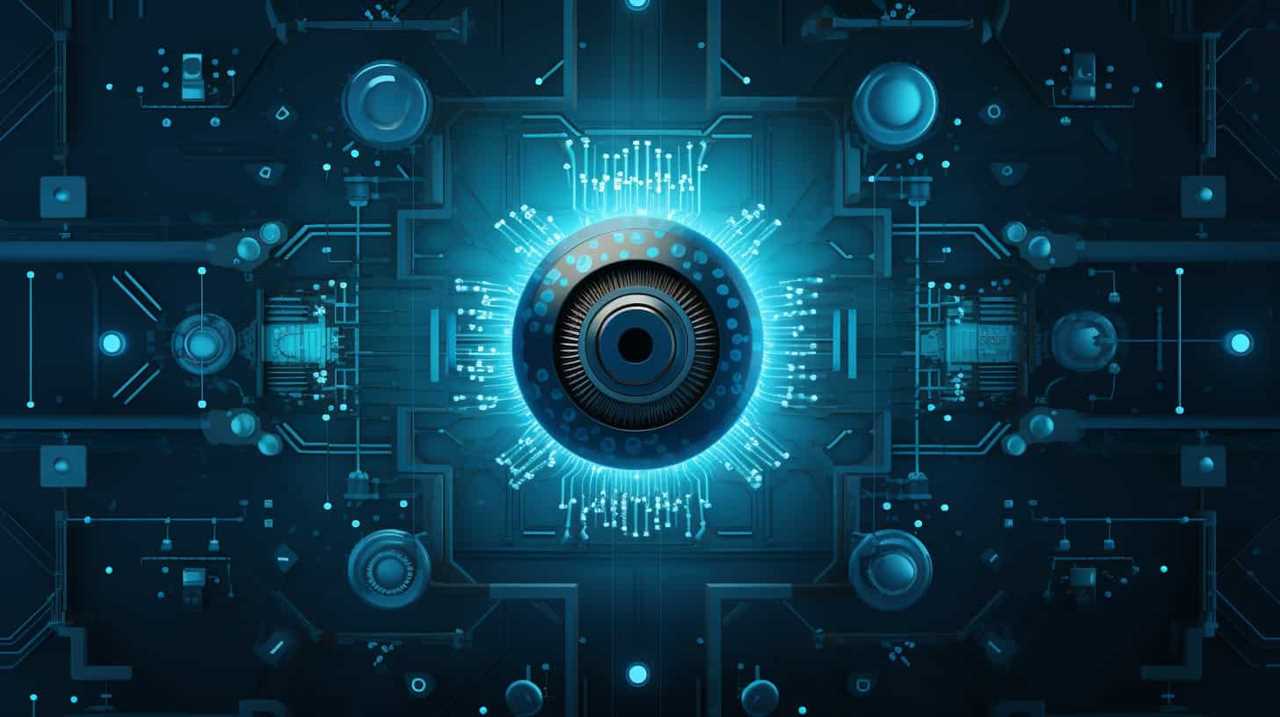When delving into the complex realm of AI security, I frequently encounter the difficulty of measuring success. What strategies can we use to accurately assess the efficiency of our security measures?
It is a delicate balance between technical prowess and analytical precision. Through key performance indicators, threat detection and response, user behavior analytics, vulnerability assessments, and continuous monitoring and improvement, we strive to master the art of evaluating our AI security measures.
Key Takeaways
- KPI tracking is essential for evaluating the performance of AI security measures and provides insights into the overall security posture and impact of AI on safeguarding sensitive information.
- Efficient threat detection and response, supported by advanced algorithms and machine learning techniques, are crucial components of AI security measures to minimize the impact on the system’s overall security posture.
- User behavior analytics enables proactive detection and response to potential security threats by analyzing user behavior patterns and identifying deviations that may indicate suspicious activity.
- Regular vulnerability assessments, including penetration testing and risk assessment, help identify weaknesses and vulnerabilities within the system and ensure timely patch management for protection against the latest threats.

Key Performance Indicators (Kpis)
I use Key Performance Indicators (KPIs) to assess the effectiveness of my AI security measures. KPI tracking plays a crucial role in evaluating the performance of these measures.
By monitoring specific KPIs, I can measure the success of my AI security implementation and make data-driven decisions to improve its effectiveness.
When it comes to performance evaluation, KPIs provide valuable insights into the overall security posture and the impact of AI on safeguarding sensitive information. These indicators allow me to quantify the effectiveness of various security controls, such as anomaly detection algorithms and access control mechanisms.
Through KPI tracking, I can identify areas that require improvement, pinpoint vulnerabilities, and ensure that my AI security measures are meeting the desired objectives.

Threat Detection and Response
One key aspect of my AI security measures is the efficient detection and response to threats. Incident prevention and threat intelligence are crucial components of this process.
By utilizing advanced algorithms and machine learning techniques, my AI system continuously scans and analyzes network traffic, looking for any suspicious activity that may indicate a potential threat. It uses threat intelligence feeds to stay updated on the latest known threats and patterns, enabling it to detect and respond to emerging threats effectively.
When a threat is detected, my AI system quickly initiates the appropriate response, whether it be blocking the suspicious activity, alerting security personnel, or initiating a remediation process. This proactive approach to threat detection and response ensures that potential security breaches are identified and addressed promptly, minimizing the impact on the system’s overall security posture.
In the next section, we’ll explore the role of user behavior analytics in enhancing our AI security measures.

User Behavior Analytics
To evaluate the effectiveness of my AI security measures, I employ user behavior analytics. User behavior analytics is a powerful tool that allows me to understand and analyze how users interact with my system, enabling me to identify and detect any abnormal behavior or potential security threats.
By analyzing user behavior patterns and comparing them to established baseline profiles, I can identify deviations that may indicate suspicious activity. This behavior analysis involves monitoring various user actions, such as login attempts, file access, and data transfers.
I also utilize anomaly detection techniques to flag any unusual or unexpected behavior that could pose a security risk. User behavior analytics provides me with valuable insights into the actions of users within my system, enabling me to proactively detect and respond to potential security threats.

Vulnerability Assessments
Continuing the evaluation of effectiveness in assessing AI security measures, vulnerability assessments are crucial for identifying potential weaknesses and vulnerabilities within the system. To ensure comprehensive security, the following steps are taken:
- Penetration testing: This process involves simulating real-world attacks to assess the system’s resilience. By attempting to exploit vulnerabilities, we can identify weak points and take necessary measures to strengthen them.
- Risk assessment: Conducting a thorough risk assessment helps in understanding the potential impact and likelihood of different vulnerabilities. This assessment allows us to prioritize mitigation efforts based on the severity of each vulnerability.
- Regular scanning and monitoring: Continuous scanning and monitoring of the system help detect new vulnerabilities or changes in the existing ones. This proactive approach enables us to address vulnerabilities promptly and minimize the window of opportunity for potential attacks.
- Patch management: Timely application of security patches and updates is crucial to address known vulnerabilities. Regular patch management ensures that the system is protected against the latest threats.

Continuous Monitoring and Improvement
I continuously monitor and improve our AI security measures to ensure their effectiveness. Continuous monitoring involves regularly assessing the performance and behavior of our AI systems, as well as the security controls that surround them. This process allows us to identify any potential vulnerabilities or weaknesses that may arise over time.
By analyzing and interpreting the data collected through continuous monitoring, we can gain insights into the evolving threat landscape and make informed decisions to mitigate risks. Additionally, continuous learning plays a crucial role in improving our AI security measures. By staying updated on the latest advancements in AI security and incorporating new strategies and technologies, we can enhance our defenses against emerging threats.

Frequently Asked Questions
Are There Any Legal or Ethical Concerns Associated With the Use of AI in Security Measures?
There are indeed legal and ethical concerns associated with the use of AI in security measures. It is important to carefully consider the potential implications and consequences, ensuring that AI systems are designed and used in a responsible and accountable manner.
How Does the Effectiveness of AI Security Measures Compare to Traditional Security Methods?
In comparing the effectiveness of AI security measures to traditional methods, it is crucial to consider the limitations and challenges. While AI offers remarkable potential, it is not a panacea and requires careful evaluation to ensure optimal results.
What Steps Are Taken to Ensure the Privacy and Protection of User Data When Implementing AI Security Measures?
To ensure privacy and protection of user data with AI security measures, we employ data encryption and data access controls. These measures safeguard sensitive information and prevent unauthorized access, maintaining the integrity and confidentiality of user data.
How Are AI Security Measures Integrated With Existing Security Systems and Protocols?
When integrating AI security measures with existing systems and protocols, challenges arise. However, by following best practices, we can ensure a seamless integration that enhances overall security and protects against potential vulnerabilities.
What Are the Potential Limitations or Challenges of Relying on AI for Threat Detection and Response?
The potential challenges and limitations of relying on AI for threat detection and response include accuracy and adaptability. AI systems may struggle to accurately detect and respond to complex and evolving threats, requiring constant updates and adjustments.

Conclusion
In evaluating the efficacy of our AI security measures, we employ Key Performance Indicators (KPIs), threat detection and response, user behavior analytics, vulnerability assessments, and continuous monitoring and improvement.
By diligently measuring and analyzing these factors, we can confidently ascertain the effectiveness of our security protocols.
This comprehensive approach allows us to proactively identify and mitigate potential risks, ensuring the utmost protection of our systems and data.









